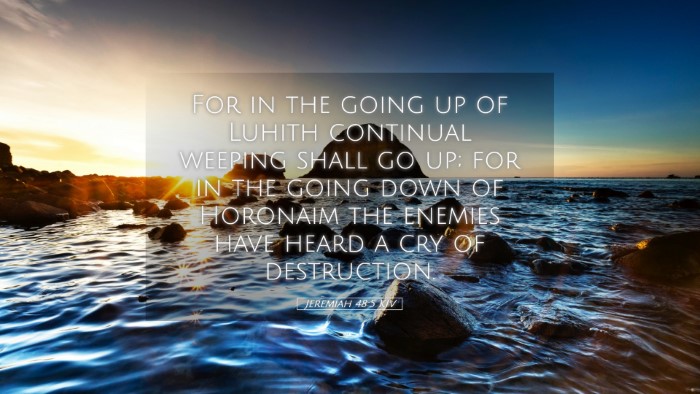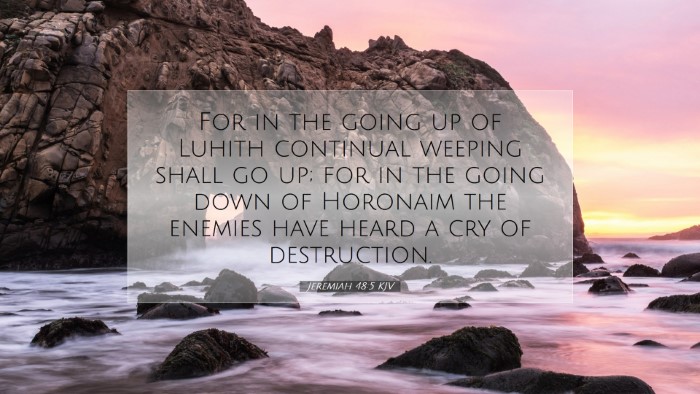Commentary on Jeremiah 48:5
Introduction
Jeremiah 48:5 speaks of the sorrow and lamentation of Moab, a nation that experienced the consequences of its actions and the coming judgment of God. The verse states, “For in the ascent of Luhith, with weeping they shall go up; for in the descent of Horonaim the enemies have heard a cry of destruction.” This passage encapsulates the themes of judgment, mourning, and the reality of divine retribution that pervades the prophetic literature.
Mourning and Lamentation
Matthew Henry notes that the image of weeping on the ascent of Luhith underscores the severity of Moab's impending destruction. The reference to an ascent indicates a struggle, as the people travel uphill burdened by grief and loss. As they ascend, their tears symbolize their recognition of the consequences of their sin, a state of despair that is common in prophetic warnings.
Albert Barnes adds that the use of "weeping" in this context signifies not just sorrow but an acknowledgment of guilt. The people of Moab, faced with devastation from their enemies, are portrayed as helpless and in deep distress. It is a reminder to both the ancient audience and modern readers that sin leads to suffering; they cannot escape the repercussions of their actions.
Symbolisms of Locations
In this verse, significant locations are mentioned: Luhith and Horonaim. Adam Clarke emphasizes the geographical imagery that serves to heighten the sense of tragedy. Luhith, being a place of ascent, symbolizes hope or a struggle for survival, whereas Horonaim, an area associated with descent, represents disaster and doom. The dynamics between these two locations illustrate the highs and lows of life, underscoring the concept of inevitable decline following moral failure.
The Nature of Divine Judgment
The imagery used in Jeremiah 48:5 indicates that divine judgment is not arbitrary; it is a response to the moral and spiritual decay of the nations. Jeremiah’s prophecies often emphasize that God’s anger results from the persistent idolatry and immorality of His people. Matthew Henry points out that the cry of destruction heard at Horonaim symbolizes God's righteous wrath against sin. This theme informs pastoral teaching today: an essential aspect of God's character is His justice, which cannot overlook wrongdoing.
Historical Context
Jeremiah prophesied during a tumultuous period in Israel’s history, with Moab being a recurrent antagonist. The collapse of Moab calls to mind the larger theme of the nations surrounding Israel and their fates in relation to God’s covenant people. Albert Barnes suggests that understanding Moab’s historical background adds depth to the judgment depicted. Moab's origins, linked to the incestuous union of Lot and his daughters, carry cultural implications of sinfulness and moral failure leading to their ultimate downfall.
Lessons for Today
This verse provides significant lessons applicable to contemporary society. One takeaway is the importance of recognizing the consequences of our moral choices. Just as Moab faced judgment, modern nations and individuals must confront their failings and the potential repercussions of sin. Clarke articulates this by emphasizing that God’s discipline is one of His ways to guide nations towards repentance before it’s too late.
Moreover, pastoral teachings can draw from Jeremiah 48:5 to address grief and the process of lamentation. It provides a framework for understanding how sorrow can transform into hope when aligned with divine justice. The understanding that God responds to sin with judgment serves as both a warning and an invitation to repentance.
Conclusion
Jeremiah 48:5 is a poignant reminder of the intertwining of sin, judgment, and the human condition. By synthesizing insights from public domain commentaries, we illuminate the rich meanings behind the text. This verse challenges readers to examine their own lives, societies, and the nature of their relationship with God. As we reflect on the lessons from Moab's story, may we pursue righteousness and heed God's calls to repentance to avoid similar fates.


